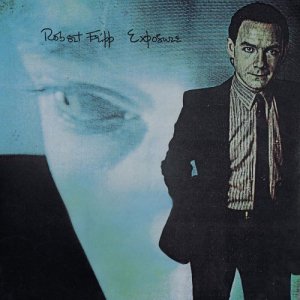Continuing with King Crimson Week here at Replicant Ears, I present to you my top five Crimson spin-off records. These are records released by members of the band either before their joining, immediately or soon after leaving, or as just a temporary diversion from the band itself. All Crim members, past and present, are legendary in their own ways, and there’s a lot of great stuff out there that was released by them, so this was a bit of a challenge to say the least! Let’s begin.
5. McDonald and Giles – McDonald and Giles (1971)
Woodwind/keyboard player Ian McDonald and drummer Michael Giles released this little gem a couple of years after leaving King Crimson’s very first line-up. Not only does the record benefit from the very capable and familiar talents of the two gentlemen (and the fact that McDonald was a key architect when it came to writing that signature Crimson sound found on the band’s 1969 debut), McDonald and Giles is also a more light-hearted affair. It lacks the scathing turmoil found on “21st Century Schizoid Man” and the melodrama of “The Court of the Crimson King.” With Giles providing lead vocals on some of the duo’s chipper, quite English-sounding songs, the record is altogether more like the Crimson precursor, The Cheerful Insanity of Giles, Giles and Fripp. The album is a must for any Crim fans. “Suite In C” is notable in CD format for its overdub of the phrase ‘soft pussy.’ It is replaced by ‘black kitten.’ The playful, Beatles-esque immediacy of “Tomorrow’s People” and an alternate version of Crimson’s “Cadence and Cascade” (from In the Wake of Poseidon,) called “Flight of the Ibis,” put the cherry on top. The cover of the record features McDonald and Giles with their respective girlfriends.
Highlights: “Suite in C,” “Flight of the Ibis,” “Tomorrow’s People – The Children of Today”
4. The Keith Tippett Group – You Are Here… I Am There (1970)
This album was released before jazz pianist Keith Tippett’s involvement with King Crimson. He got his start on the band’s first post-In the Court single “Cat Food” and would later feature prominently on the albums Lizard (1970) and Islands (1971). On his own album, Tippett demonstrates exactly why he was chosen to become an integral part of the early Crimson sound. While You Are Here is entirely a jazz record, it features the complex compositions and recurring motifs that were the cornerstones of the 1969-1971 Crimso. The album features a fabulous line-up including the great Elton Dean on sax and two members, Mark Charig (cornet) and Nick Evans (trombone), who would appear with Tippett on the aforementioned Crimson albums. Charig would also make an appearance on the epic 1975 album Red. The brilliance of “Stately Dance” is definitely something that true Crim fans should witness. If you find nothing else in this record (and if you can’t you’re a damaged individual), check out the wonderful surprise that “Thank You for the Smile” develops into.
Highlights: “This Evening Was Like Last Year,” “Thank You for the Smile,” “Stately Dance for Miss Primm”
3. Jakszyk, Fripp and Collins – A Scarcity of Miracles (2011)

New King Crimson comes along when you least expect it. Although A Scarcity of Miracles is billed as ‘A King Crimson ProjeKct,’ I really must insist that it is a proper Crimson album. After all, it features current Crimson members Robert Fripp, Jakko M. Jakszyk, Mel Collins, Tony Levin, and Gavin Harrison, and is a wonderful, if sedate, tip of the hat to the band’s early work. For the sake of keeping things orderly, I’m willing to call Scarcity a spin-off for the time being (until after this Friday, in fact). This album saw Jakszyk taking the role of lead vocalist as he had in the 21st Century Schizoid Band, but this time performing all original material… a test he passed with flying colours. While A Scarcity of Miracles sees legendary saxophonist Mel Collins in his more modern shoes, the soothing complexity of the guitars and the steady hum of the rolling rhythm section provides the perfect backdrop for a more mature Collins than we were used to in 1970/71. The lyrics are also fantastic and Jakszyk manages to roll almost all of the band’s past vocal styles into one oddly familiar sound. This one is definitely a winner in my books.
Highlights: “A Scarcity of Miracles,” “The Price We Pay”
2. Gordon Haskell – It Is and It Isn’t (1974)
It Is and It Isn’t is one of the most criminally underrated of the Crimson spin-off records. While he made his debut in the band on one song, “Cadence and Cascade,” on In the Wake of Poseidon, Gordon Haskell’s first, and only, full-on record as the band’s lead vocalist and bassist was 1970’s challenging and epically different Lizard. While he claimed he felt he was the square peg in the group, it is perhaps this that gave that record such a warm, yet somehow even more deranged feeling than normal. It Is and It Isn’t came a few years after his leave of the group and, unlike a lot of his later work, it does carry a very proggy vibe. Although it is mostly a folk rock record, It Is and It Isn’t feels like it was made with Crimson fans at least partially in mind. With his distinct, round voice in its own territory and comfort zone, and his own songs brilliantly carrying him along, Haskell shows off all that he is capable of and cements his place as my favourite Crim vocalist. Although he never fit in quite as well as all the rest, I feel a certain blissful, old school English melancholy in his voice that lent itself perfectly to the Crimson of the time. It Is and It Isn’t also features King Crimson alumnus John Wetton on bass and backing vocals, adding yet another point to the album’s tally.
Highlights: “Worms,” “Could Be,” “Upside Down,” “No Need,” “No Meaning”

Gordon Haskell (second from right) with King Crimson in 1970, L-to-R: Robert Fripp, Mel Collins, Andy McCulloch, Pete Sinfield.
1. Robert Fripp – Exposure (1979)
After officially disbanding King Crimson in 1975, the master himself finally released a solo album of his own in 1979. This exceptionally crafted art-pop masterpiece almost chronicles Fripp’s post-Crim adventures. Venturing across the pond and settling in Hell’s Kitchen, New York’s alternative scene seems to have rubbed off on the artist for this one. Exposure features a wide variety of styles, including the more familiar (“Breathless”), the neo-beatnik (“You Burn Me Up I’m A Cigarette”), the downright soothing (“North Star”), and of course some ambient Frippertronics (“Water Music”). With stellar vocalists, Daryl Hall, Peter Gabriel, Peter Hammill, and Terre Roche, Fripp’s Exposure covers some serious ground and captures the gritty underbelly of the art-pop movement flagshipped by The Talking Heads, Eno, Blondie, et al., whilst also showcasing some of the master guitarists amazing abilities in the best possible way. It totally foreshadows the form Crim would take when they reunited in 1981. If there is a most important King Crimson record that isn’t a King Crimson record, it is this one.
Highlights: “NY3,” “Here Comes the Flood,” “Breathless,” “North Star”
RYAN SMITH spends a great deal of his time under troll bridges shaking his fist and hollering obscenities at the mainstream, but occasionally finds himself on the side of a pop act that the underground has disowned. A schizoid fan for the 21st century? Although he has a diverse musical taste that runs the gamut from black metal to country to most forms of jazz, Ryan’s first love will always be progressive music.










Thank You for taking the time & effort to write this, I do however submit the list is too short.
No Adrian Belew recording? Surprising.
No Bruford work? Preposterous!
All the same, thanks again
;-p
Thanks for your response!
Forgive me if the first four Crim records have a more special
place in my heart.
I’ll be the first to admit that the list is too short,
but five is the format I elected to use, and it was a
challenge. The above article is just the opinion of
one fan.
And I love Belew and Bruford, the five records listed
above, at the end of the day, are the ones I myself
could not be without.
Cheers!
– rs